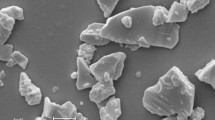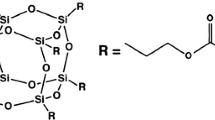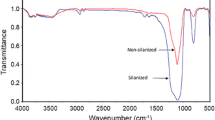Abstract
The aim of this study was to evaluate the effect of different weight fractions of nanometer sized particulate filler on properties of microfilled composite resin. Composite resin was prepared by mixing 33 wt% of resin matrix to the 67 wt% of silane treated microfine silica particulate fillers with various fractions of nanometer sized fillers (0, 10, 15, 20, 30 wt%) using a high speed mixing machine. Test specimens made of the composites were tested with a three-point bending test with a speed of 1.0 mm/min until fracture. Surface microhardess (Vicker’s microhardness) was also determined. The volumetric shrinkage in percent was calculated as a buoyancy change in distilled water by means of the Archimedes principle. The degree of monomer conversion (DC%) of the experimental composites containing different nanofiller fractions was measured using FTIR spectroscopy. Surface roughness (Ra) was determined using a surface profilometer. Nanowear measurements were carried out using a nanoindentation device. The water uptake of specimens was also measured. Parameters were statistically analysed by ANOVA (P < 0.05). The group without nanofillers showed the highest flexural strength and modulus, DC% and Ra value. The group with 30% nanofillers had the highest water uptake and volumetric shrinkage. No significant difference was found in Vicker’s microhardness and the nanowear of the composites. The plain microfilled composite demonstrated superior properties compared to the composites loaded with nanofillers with the exception of surface roughness.


Similar content being viewed by others
References
Bowen RL. Properties of a silica-reinforced polymer for dental restorations. JADA. 1963;66:57–64.
Wilder AD Jr, May KN Jr, Bayne SC, Taylor DF, Leinfelder KF. Seventeen-year clinical study of ultraviolet-cured posterior composite class I and II restoration. J Esthet Dent. 1999;11:135–42.
Manhart J, Chen H, Hamm G, Hickel R. Review of the clinical survival of direct and indirect restorations in posterior teeth of the permanent dentition. Oper Dent. 2004;29:481–508.
Rueggeberg FA. From vulcanite to vinyl, a history of resins in restorative dentistry. J Prosthet Dent. 2002;87:364–79.
Weinmann W, Thalacker C, Guggenberger R. Siloranes in dental composites. Dent Mater. 2005;21:68–74.
Ferracane JL, Berge HX, Condon JR. In vitro aging of dental composites in water―effect of degree of conversion, filler volume, and filler/matrix coupling. J Biomed Mater Res. 1998;42:465–72.
Watts DC, Hindi AA. Intrinsic soft-start polymerization shrinkage-kinetics in an acrylate-based resin composite. Dent Mater. 1999;15:39–45.
Garoushi S, Vallittu PK, Lassila LVJ. Short glass fiber reinforced restorative composite resin with semi-interpenetrating polymer network matrix. Dent Mater. 2007;23:1356–62.
Garoushi S, Lassila LV, Tezvergil A, Vallittu PK. Static and fatigue compression test for particulate filler composite resin with fiber-reinforced composite substructure. Dent Mater. 2007;23:17–23.
Tian M, Gao Y, Liu Y, Liao Y, Hedin NE, Fong H. Fabrication and evaluation of Bis-GMA/TEGDMA dental resins/composites containing nano fibrillar silicate. Dent Mater. 2008;24:235–43.
Glenn JF. Composite and properties of unfilled and composite resin restorative materials. In: Smith DC, Williams DF, editors. Biocompatibility of dental materials. Boca Ratan, FL: CRC Press, Inc; 1982. p. 97–130.
Rüttermann S, Wandrey C, Raab WH, Janda R. Novel nano-particles as fillers for an experimental resin-based restorative material. Acta Biomater. 2008;4:1835–46.
Da Costa J, Ferracane J, Paravina RD, Mazur RF, Roeder L. The effect of different polishing systems on surface roughness and gloss of various resin composites. J Esthet Restor Dent. 2007;19:214–24.
Efes GB, Dorter C, Gomec Y. Clinical evaluation of an ormocer, a nanofill composite and a hybrid compsoite at 2 years. Am J Dent. 2006;19:236–40.
Söderholm KJ, Yang MC, Garcea I. Filler particle leachability of experimental dental composites. Eur J Oral Sci. 2000;108:555–60.
International Standardization Organization ISO 10477 1992(E). Dentistry-Polymer based crown and bridge materials. Geneva, Switzerland: International Standardization Organization; 1992.
Tjong SC. Structural and mechanical properties of polymer nanocomposites. Mater Sci Eng R. 2006;53:73–97.
International Standardization Organization ISO 4049. Dentistry-Polymer based filling, restorative and luting materials. Geneva, Switzerland: International Standardization Organization; 2000
Beun S, Glorieux T, Devaux J, Vreven J, Leloup G. Characterization of nanofilled compared to universal and microfilled compsoites. Dent Mater. 2007;23:51–9.
Ilie N, Hickel R. Investigation on mechanical behaviour of dental composites. Clin Oral Invest. 2009;13:427–38.
West RD, Malhotra VM. Rupture of nanoparticle agglomerates and formulation of Al2O3-epoxy nanocomposite using ultrasonic cavitation approach: effect on the structural and mechanical properties. Polym Eng Sci. 2006;46:421–30.
Janda R, Roulet JF, Latta M, Rüttermann S. The effects of thermocycling on the flexural strength and flexural modulus of modern resin-based filling materials. Dent Mater. 2006;22:1103–8.
Ferracane JL, Condon JR. Post-cure heat treatments for composites: properties and fractography. Dent Mater. 1992;8:290–5.
Vallittu PK, Ruyter IE, Ekstrand K. Effect of water storage on the flexural properties of E-glass and silica fiber acrylic resin composite. Int J Prosthodont. 1998;11:340–50.
Lambrechts P, Goovaerts K, Bharadwaj D, De Munck J, Bergmans L, Peumans M, Van Meerbeek B. Degradation of tooth structure and restorative materials: a review. Wear. 2006;261:980–6.
Xu HHK, Quinn JB, Giuseppetti AA. Wear and mechanical properties of nano-silica-fused whisker composites. J Dent Res. 2004;83:930–5.
Drummond JL. Nanoindentation of dental composites. J Biomed Mater Res B Appl Biomater. 2006;78:27–34.
Devaprakasam D, Hatton PV, Möbus G, Inkson BJ. Nanoscale tribology, energy dissipation and failure mechanisms of nano and micro silica particle-filled polymer composites. Tribol Lett. 2009;34:11–9.
Turssi GP, Ferracane JL, Vogel K. Filler features and their effect on wear and degree of conversion of particulate dental resin composites. Biomaterials. 2005;26:4932–7.
Lehtinen J, Laurila T, Lassila LVJ, Tuusa S, Kienanen P, Vallittu PK, Hernberg R. Optical characterization of bisphenol-A-glycidyldimethacrylate-triethylene glycoldimethacryalate monomers and copolymers. Dent Mater. 2008;24:1324–8.
Rodrigues-Junior SA, Scherrer SS, Ferracane JL, Della Bona A. Microstructural characterization and fracture behavior of a microhybrid and nanofill composite. Dent Mater. 2008;24:1281–8.
Mayworm CD, Camargo SS Jr, Bastian FL. Influence of artificial saliva on abrasives wear and microhardness of dental composites filled with nanoparticles. J Dent. 2008;36:703–10.
Herbstrith Segundo RM, Goncalves Mota E, Balbinot CE, Lopes Bondan J, Silva Oshima HM. Influence of storage solution and curing method on a microhybrid composite microhardness. Minerva Stomatol. 2008;57:41–6.
Vallittu PK. Oxygen inhibition of autopolymerization of poly-met hylmethacrylate—glass fibre composite. J Mater Sci-Mater M. 1997;8:489–92.
Cassoni A, Oliveira Ferla JD, Albino LG, Youssef MN, Shibli JA, Rodrigues JA. Argon ion laser and halogen lamp activation of a dark and light resin composite: microhardness after long-term storage. Lasers Med Sci. 2010;25:829–34.
Kanchanavasita W, Anstice HM, Pearson GJ. Long-term surface micro hardness of resin modified glass inomers. J Dent. 1998;26:707–12.
Mitra SB, Wu D, Holmes BN. An application of nanotechnology in advanced dental materials. J Am Dent Assoc. 2003;134:1382–90.
Moszner N, Klapdohr S. Nanotechnology for dental composites. Int J Nanotech. 2004;1:130–56.
Uctasli MB, Bala O, Gullu A. Surface roughness of flowable and packable composite resin materials after finishing with abrasive discs. J Oral Rehabil. 2004;31:1197–202.
Barbosa SH, Zanata RL, Navarro ML, Nunes OB. Effect of different finishing and polishing techniques on the surface roughness of microfilled, hybrid and packable composite resins. Braz Dent J. 2005;16:39–44.
Author information
Authors and Affiliations
Corresponding author
Rights and permissions
About this article
Cite this article
Garoushi, S., Lassila, L.V.J. & Vallittu, P.K. Influence of nanometer scale particulate fillers on some properties of microfilled composite resin. J Mater Sci: Mater Med 22, 1645–1651 (2011). https://doi.org/10.1007/s10856-011-4352-1
Received:
Accepted:
Published:
Issue Date:
DOI: https://doi.org/10.1007/s10856-011-4352-1




